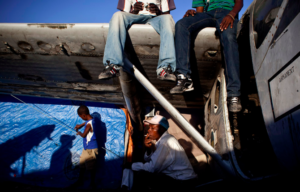Michael Kalinski, associate professor of civil engineering, and Melinda Jean-Louis, a 2012 graduate of the college who is now pursuing a master’s degree, visited the island nation for 10 days in July. There, they joined Herby Lissade from the U.S.-based humanitarian organization Haiti Engineering. The team’s mission, funded by a grant from Geoscientists Without Borders, was to gather data on soil stiffness at various sites ravaged by the catastrophic earthquake of Jan. 12, 2010.
The 7.0 magnitude earthquake, with its epicenter near the Haitian capital of Port-au-Prince, killed an estimated 300,000 people and left much of the city in rubble. Haiti — with its long history of poverty, political strife, and violence — was already reeling from devastating hurricanes two years earlier. The country has been in crisis ever since. Three and a half years later, Kalinski likens the experience of visiting the capital to camping in a landfill.
“There is garbage literally everywhere,” he said. “Open streams run right through the city, carrying all kinds of waste, including untreated sewage, while pigs, goats and chickens graze in the filth. Police presence is minimal and vigilante justice is common. This is what a world without government or infrastructure is like.”
Day-to-day life in Port-au-Prince is largely improvised and ad hoc, and for most Haitians is an exercise in survival. Four out of five Haitians are unemployed, and most who do work earn the U.S. equivalent of $400 per year or less. Many of the city’s residents squat in ramshackle buildings that tilt on their foundations in various stages of collapse. With few regular stores open, people line the streets in a perpetual makeshift bazaar, selling just about anything they can get their hands on. Food and clean water are frequently in short supply. Electrical power is extremely unreliable.
“It was a constant challenge to find electricity to power our laptops and instruments,” Kalinski said. “Everywhere we went, we were always looking for ways to store electricity here and there. We would charge our laptops using inverters in cars, even if it was just a five-minute drive. We would use small USB-powered fans to cool ourselves at night because there was no electricity in the house.”
In the absence of reliable government programs to provide essential services to the population, Haitians have traditionally depended on the Catholic Church. The church is responsible for much of the social and physical infrastructure within the communities. The local church buildings might function as the de facto town hall, community center, school, and medical clinic all in one.
A countless number of churches in and around Port-au-Prince were brought down by the earthquake of 2010. Many of those that still stand have sustained serious damage. Some have been reduced to open-air altars, where services are still performed. Before any rebuilding can take place, engineers need to perform a seismic site response analysis to find out how the ground stiffness will affect shaking when the next earthquake comes.
“Structures respond differently to earthquake stresses depending on how stiff the soil underneath them is,” Kalinski said. “The impact of seismic waves is amplified by soft soil, and buildings on soft soil will typically shake more severely, and thus suffer much more damage, than those built on stiff soil or rock.”
However, Haitian geoscientists may not have the appropriate technology or expertise to perform suitable analysis, Kalinski said. The UK/Haiti Engineering project is aimed at addressing this deficiency, using new, relatively inexpensive and portable technology to measure soil stiffness. Working with local geoscientists and practitioners, the team performed tests at seven different sites during their visit in July.
Jean-Louis, the graduate student, is currently working on analysis of the data the team collected, which will help Haitian engineers develop more earthquake-resistant designs. Jean-Louis was born in Haiti, but her family moved to the United States in 2004. Her father’s work eventually brought the family to Lexington, where she graduated from Bryan Station High School in 2008.
“I am glad that I have a project like this to work on, instead of just writing a paper,” Jean-Louis said. “I am always interested in doing something constructive, especially where Haiti is involved. This was just a perfect opportunity for me.”
The team’s work was very well received, Kalinski said. They made a presentation to the Papal Nuncio to Haiti (The Vatican’s ambassador to Haiti), who will report to the Vatican in order to identify similar needs in other parts of the world. Another important part of the project is the transfer of technology to local geoscientists in Haiti.
“We will return to Haiti later this fall to present seminars to Professor Christian Rousseau and his students at the University of Haiti, along with other interested geoscientists and practitioners,” Kalinski said. “Ultimately, practitioners in Haiti will be able to perform the testing and do the analyses themselves.”
